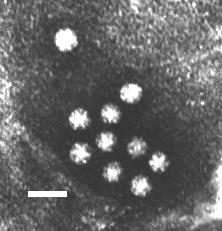
Stool sample from an individual with gastroenteritis.
Negative-stain Transmission Electron Microscopy. Bar = 50 nanometers.
F.P. Williams, U.S. EPA

Stool sample from an individual with gastroenteritis.
Negative-stain Transmission Electron Microscopy. Bar = 50 nanometers.
F.P. Williams, U.S. EPA
 Positive sense single-stranded RNA
(+ssRNA)
Positive sense single-stranded RNA
(+ssRNA) Nonenveloped
Nonenveloped Icosahedral capsid
Icosahedral capsid Small size (28-30 nanometers in diameter)
Small size (28-30 nanometers in diameter) Round viruses with characteristic starlike
surface appearance when viewed by electron microscopy, hence the name Astroviridae. Stars may be five-
or six-pointed.
Round viruses with characteristic starlike
surface appearance when viewed by electron microscopy, hence the name Astroviridae. Stars may be five-
or six-pointed. A ubiquitous virus, astrovirus infections are found
worldwide.
A ubiquitous virus, astrovirus infections are found
worldwide. Young children, especially in childcare settings, are most
likely to develop clinical illness.
Young children, especially in childcare settings, are most
likely to develop clinical illness. Elderly patients in nursing facilities and military recruits
have also experienced outbreaks of astroviral gastroenteritis. Astrovirus is an important cause of
enteric disease in immunocompromised individuals, too.
Elderly patients in nursing facilities and military recruits
have also experienced outbreaks of astroviral gastroenteritis. Astrovirus is an important cause of
enteric disease in immunocompromised individuals, too. Similar to rotavirus, astrovirus infections tend to occur
during winter months in temperate regions and in the rainy season in tropical regions.
Similar to rotavirus, astrovirus infections tend to occur
during winter months in temperate regions and in the rainy season in tropical regions. More refined detection techniques, such as reverse
transcription-polymerase chain reaction (RT-PCR), have demonstrated that astrovirus infection is more
common and important to viral gastroenteritis than previously shown.
More refined detection techniques, such as reverse
transcription-polymerase chain reaction (RT-PCR), have demonstrated that astrovirus infection is more
common and important to viral gastroenteritis than previously shown. There is no vaccine for astrovirus
There is no vaccine for astrovirus Personal hygiene and decontamination of outbreak settings
are important to reducing transmission and infection
Personal hygiene and decontamination of outbreak settings
are important to reducing transmission and infection Individuals can continue to shed astrovirus in their feces several days
after illness resolves, and so should continue to take precautions after recovering from
overt illness.
Individuals can continue to shed astrovirus in their feces several days
after illness resolves, and so should continue to take precautions after recovering from
overt illness. There is no anti-viral treatment for astrovirus infection,
and astroviral disease rarely requires hospitalization
There is no anti-viral treatment for astrovirus infection,
and astroviral disease rarely requires hospitalization However, young children who are at risk due to preexisting
malnutrition or illness should be treated with oral rehydration therapy (ORT) to avoid severe
consequences of gastroenteritis. ORT is also used for rotaviral infections and other diarrheal
diseases, such as cholera.
However, young children who are at risk due to preexisting
malnutrition or illness should be treated with oral rehydration therapy (ORT) to avoid severe
consequences of gastroenteritis. ORT is also used for rotaviral infections and other diarrheal
diseases, such as cholera. Matsui SM, Greenberg HB. "Astroviruses." Chapter 28 in Fields
Virology, 4th edition. Fields B, Knipe D, Howley P, eds. Lippincott-Raven: Philadelphia, 2000
(875-893)
Matsui SM, Greenberg HB. "Astroviruses." Chapter 28 in Fields
Virology, 4th edition. Fields B, Knipe D, Howley P, eds. Lippincott-Raven: Philadelphia, 2000
(875-893) The
Astrovirus Homepage of the Institute for Animal Health
The
Astrovirus Homepage of the Institute for Animal Health ICTV - International Committee on the Taxonomy
of Viruses
ICTV - International Committee on the Taxonomy
of Viruses All the Virology on the WWW
All the Virology on the WWW